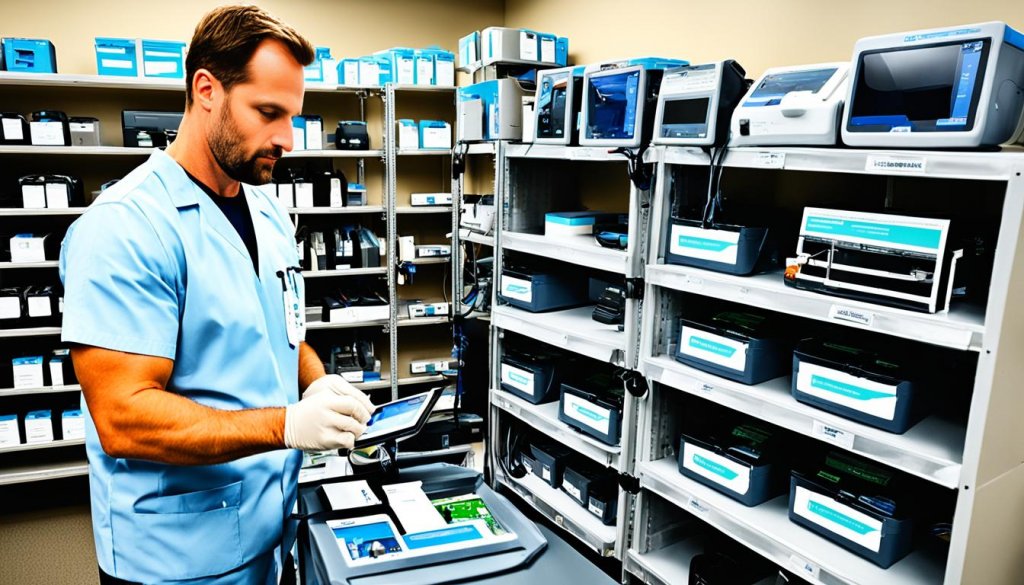Have you ever thought about how bad inventory management can hit healthcare hard, not just in the wallet but also in patient care? In the medical equipment world, managing the supply chain makes up over 37% of what it costs to care for patients. It’s key for places to get their inventory right. Doing so means having the right supplies ready for patients and keeping things running smoothly.
This article will look into the big hurdles of managing medical equipment inventory. We’ll talk about the problems of not having clear data and the trouble of getting supplies on time. But we’ll also share ways to change the game with technology and smart practices. By using top-notch inventory software, hospitals can cut down on mistakes, waste less, and improve patient care.

Key Takeaways
- Effective inventory management is crucial for seamless healthcare operations.
- Automated systems dramatically improve patient outcomes by reducing errors.
- Just-in-Time (JIT) systems minimize storage costs, especially for perishable supplies.
- Data analytics provides valuable insights for controlling costs and optimizing stock levels.
- Choosing the right inventory tracking system is essential in managing supply efficiently.
Understanding the Importance of Inventory Management in Healthcare
Inventory management is key in healthcare. It makes up over 37% of the costs for patient care. In the U.S., hospitals spend about USD 83 billion each year on things like gloves and gowns.
More than a third of hospital budgets go to managing and restocking supplies. This shows how crucial it is to use resources well.
Managing the medical supply chain is vital for uninterrupted care. It cuts costs and improves quality. With the right software, I can keep track of supplies, fix shortages fast, and make buying easier.
If inventory management is poor, it can lead to lower payments and risks to patient safety.
Using Just-in-Time (JIT) strategies in hospitals saves money, about USD $3–11 million a year. This means savings of 10%–17%. JIT systems also make inventory turnover and workflow better.
Good inventory management and technology help reduce stress on healthcare staff. They can focus more on caring for patients.
The Key Challenges in Medical Equipment Inventory Management
Managing medical equipment inventories is tough and affects healthcare quality. Stock discrepancies come from old methods and mistakes in entering data manually. I often see problems like not having enough items or using too much and wasting them, which hurts patient care. Bad inventory management also means wasting money and making healthcare harder to manage.
To get better, I’ve found that a good medical inventory tracking system is key. This tech keeps track of stock accurately with barcode scanning and RFID tags. Using automated solutions makes using resources better and keeps costs down. Knowing how long things take to arrive is also crucial to avoid running out of supplies.
Having strong relationships with suppliers is very important for managing hospital inventories. Good communication and negotiating contracts can get better deals and better delivery times. Following rules is also key, as every step in buying must follow industry standards. By tackling these issues early, healthcare providers can reduce waste and protect patient care, making things run smoother.
Optimizing Stock Levels for Medical Equipment
In healthcare, managing medical equipment stock is key. It’s all about finding the right balance. By using forecasting, I can predict what we’ll need and avoid too much or too little stock. This way, we always have the right equipment ready when it’s needed.
Using smart inventory management helps healthcare facilities run better. It’s about making sure we use our resources well. This means we can buy what we need without wasting time or money. It also helps us work better with suppliers, getting the best products reliably.
Managing data is crucial for good inventory control. It lets me see and manage stock across different areas easily. This leads to smarter decisions and fewer mistakes. It also helps us turn stock over faster, which is good for our budget.
By using new methods like Just-In-Time inventory and demand-driven systems, we can cut waste and save money. Keeping detailed records helps me make smart buying choices. This keeps our healthcare facility ready and able to serve patients well.
Creating Strong Supplier Relationships
Building strong partnerships with suppliers makes managing medical equipment inventory more efficient. Trust and transparency are key for good communication. This leads to solving problems together and better service.
Building Trust and Transparency
Trust comes from regular talks with suppliers. Talking openly helps find ways to improve together and lower risks. Sharing forecasts and needs leads to more accurate predictions.
This means getting supplies and equipment on time. It makes the healthcare supply chain work better.
Negotiating Effective Supply Contracts
Negotiating contracts should aim for deals that help both sides. Good negotiations get better terms without sacrificing quality. Regular checks on supplier performance help keep things running smoothly.
This also finds ways to save money beyond just cutting prices. Working together can lead to new products and services. This happens through joint investments in research and development.

Leveraging Technology for Efficient Inventory Management
In today’s fast-paced healthcare world, using technology is key for managing inventory well. Automated systems are changing how healthcare places manage their stock. By using software for managing healthcare equipment, we can cut down on mistakes and make stock management more precise.
These new tools help keep accurate records and let us monitor inventory in real-time. This makes managing stock much easier.
Automated Inventory Management Solutions
Automated systems are changing healthcare for the better. In 2022, the market for tracking and managing hospital assets was worth $25.28 billion. It’s expected to grow to $35.16 billion by 2027.
Organizations that use these systems see better accuracy, lower costs, and better patient care. Old ways of tracking stock often lead to mistakes, causing stockouts and higher costs. Automation helps streamline inventory, giving healthcare workers real-time stock updates.
This technology also helps predict supply and demand better. AI-powered solutions are key in making decisions, leading to better use of resources.
Utilizing Inventory Control Software for Medical Facilities
Advanced inventory control software gives deep insights into how supplies are used. By looking at past data and predicting future needs, places can avoid overstocking and make sure they have enough supplies. Kissflow’s software is great because it helps teams work together better, with automated workflows and dashboards.
Adding AI and machine learning makes inventory management even better, helping make decisions and keeping patients safe. These tools automate routine tasks, letting healthcare workers focus on more important work. This makes everyone more productive.
Maintaining Regulatory Compliance in Inventory Practices
In the healthcare sector, keeping up with inventory compliance is key. It’s a big task to follow the changing rules for managing medical supplies. Every healthcare place needs to know about the important standards for good patient care.
Doing inventory checks once a year is a must. It helps spot and fix any weak spots in following the rules. Using a system that tracks supplies in real time keeps everything up to date. This is where software for managing inventory can really help, making things clearer for everyone.
It’s important to set a minimum stock level for important items and watch for when things expire. This keeps patients safe from old medicines and supplies. Keeping track of medical equipment is also key for following the rules. Using new tech like RFID and barcodes makes things more accurate and efficient. By using these methods together, we can make sure our inventory is in line with the rules, keeping the place safe and putting patients first.
Streamlining Inventory Tracking with Data Analytics
In healthcare, keeping an eye on inventory levels is key. Using data analytics for tracking medical device inventory is crucial. It helps in managing restocking and avoiding shortages. With advanced tech, I can keep our medical facilities well-stocked and efficient.
Real-Time Data Monitoring
Real-time data monitoring is vital for managing inventory well. Automated systems help me spot stock issues fast and fix them early. This approach cuts down on waste and keeps patients safe. Using RFID tracking and AI in replenishment systems helps predict demand accurately, reducing the chance of running out of stock.
Improving Decision-Making through Accurate Reporting
Data-driven decisions are key to good inventory management. Detailed reports from free medical inventory software show usage patterns and trends. This helps procurement teams make smart choices about inventory levels. Regular checks on the inventory system lead to better performance and ongoing improvement.
Implementing Just-in-Time (JIT) Inventory Strategies
In today’s fast world, using JIT inventory management helps healthcare groups a lot. It makes sure supplies come just when they’re needed. This cuts down on storage costs and helps with cash flow. Big names like Target Corporation and Walmart Inc., and fast-food giants Burger King and McDonald’s, have made this work well for them.
Benefits of JIT in Healthcare Supply Chains
JIT does more than just save money. It keeps quality up, cuts waste, boosts productivity, and strengthens supplier ties. It builds a strong culture of efficiency and quick response. For healthcare, JIT means steady production, smooth workflows, and a reliable supply chain.
Adding vendor-managed inventory (VMI) systems can take these benefits further. Suppliers can then keep track of and restock inventory as needed.

Addressing the Risks of JIT Systems
Even with big advantages, JIT systems come with risks for healthcare groups. Shortages can happen when demand spikes unexpectedly. It’s key to have well-coordinated supplier relationships. Good forecasting and talking ahead are crucial.
It’s important to keep an eye on your processes and adjust when needed. This helps avoid service disruptions and keeps patient care up to standard.
Healthcare Inventory Optimization Strategies
In the fast-paced world of healthcare, having the right medical supplies is key. It’s important to use resources wisely to avoid waste. By keeping an eye on how supplies are used, I can plan better for the future and cut down on waste.
Monitoring Usage Patterns
Knowing how supplies are used helps me predict what we’ll need next. This can save a lot of money. For example, planning for surgical supplies can save about $1,800 per surgery.
Using advanced analytics tools gives me a clear picture of our inventory. This helps me make smart choices about what to stock up on. When dealing with many vendors and thousands of products, this is crucial.
A perpetual inventory management system offers real-time tracking. This lets me keep a close eye on our supplies at all times. It might cost more, but it’s worth it for the control it gives me.
Effective Resource Allocation Techniques
Advanced software can make managing resources in healthcare much more efficient. A good clinical inventory management system makes things like documentation easier. It also helps make sure we get paid for the supplies used during procedures.
Using barcodes and tags helps track even the most perishable items. This reduces the chance of missing or expired stock. These strategies ensure supplies are used wisely, improving care for everyone.
Overcoming Excessive Utilization and Waste
Minimizing medical supply waste is key to good inventory management in hospitals. A reliable tracking system is essential. It helps monitor supply use and alerts when stock is low. This leads to smarter decisions and better use of resources.
Creating a culture of responsibility and efficiency helps reduce costs. Proper inventory management means supplies are always on hand, keeping patients safe. Quick access to items lowers the chance of delays or mistakes, improving patient care.
Advanced inventory management boosts productivity in healthcare. It lets staff focus more on patient care. I’ve seen how well-managed systems cut down on staff stress and improve satisfaction.
To overcome waste, we need a strong strategy. It should focus on good systems and support. Using the right tools keeps medical supplies available and controls waste costs. This makes healthcare more effective.
Utilizing an Equipment Tracking System for Better Oversight
In today’s healthcare world, a tracking system for medical equipment is key. It helps keep an eye on medical assets. With U.S. hospitals losing nearly $4,000 per bed each year, managing equipment well is vital.
Equipment theft costs hospitals $52 million a year. A good tracking system helps find important equipment fast. This cuts down on buying too much equipment.
Tracking medical assets makes hospitals work better. It helps with keeping equipment in good shape and lowers the risk of sudden breakdowns. This keeps the hospital ready to work and helps fight infections.
With asset tracking, I get the right data for making smart choices. This data shows when equipment needs maintenance, how well it works, and if it’s available. The market for tracking and managing hospital assets is growing fast, to $35.16 billion by 2027. So, using a good tracking system is a smart move for hospitals.
Conclusion
Successful inventory management in healthcare is key to good patient care and efficient operations. The challenges in managing medical equipment can make it hard to give the best care. By building strong supplier relationships, using advanced technology, and managing stock well, we can make inventory management better.
With good inventory management, healthcare groups can cut costs and make managing supplies clearer. This means having the right equipment when it’s needed, which helps improve healthcare services. Using automated solutions and strong inventory software helps avoid extra costs and waste.
Being proactive with inventory management saves money and keeps patients safe and happy. As we make our processes better, we’ll see not just lower costs but also a stronger healthcare system. This system will be ready to serve our communities well.
See how FieldAx can transform your Field Operations.
Try it today! Book Demo
You are one click away from your customized FieldAx Demo!
FAQ
What is medical equipment inventory management?
Medical equipment inventory management is about keeping track of all the medical supplies and equipment in healthcare places. It makes sure they are always ready for use. This includes keeping accurate records, checking stock levels, and making sure to get what’s needed efficiently.
Why is effective resource allocation important in healthcare inventory management?
It’s key because it helps healthcare places manage their supplies well. This means they always have what they need. It stops problems in patient care and makes things run smoother.
What challenges do healthcare facilities face in inventory management?
They often struggle with stock issues, old ways of doing things, and not talking well with suppliers. They also face stockouts and having too much stock, which can mess up patient care.
How can data analytics improve inventory tracking?
Data analytics gives healthcare places real-time info on what they have, how it’s used, and trends. This helps them manage better, predict needs, and restock on time. It makes decisions better.
What are Just-in-Time (JIT) inventory strategies?
JIT means getting supplies as they’re needed to cut down on storage costs and waste. But, it requires working closely with suppliers to handle sudden increases in demand.
How can advanced inventory control software help in healthcare?
Advanced software makes managing inventory more accurate and efficient. It automates tracking, cuts down on mistakes, and gives detailed reports on how supplies are used. This helps in making better choices.
What regulations should healthcare organizations adhere to in inventory management?
They need to know about rules that affect how they buy and manage supplies. Following these rules keeps their supplies safe and trustworthy.
How can I build strong relationships with suppliers for inventory management?
To build good relationships, talk openly, trust each other, and solve problems together. Making deals that work for both sides and checking on how suppliers do helps get better service and timely deliveries.
What strategies can help in overcoming excessive utilization and waste?
Using strong tracking systems helps watch how supplies are used. Setting up alerts for when stock is low and teaching staff to use things wisely can cut down on waste and save money.
Author Bio
Co-Founder & CMO at Merfantz Technologies Pvt Ltd | Marketing Manager for FieldAx Field Service Software | Salesforce All-Star Ranger and Community Contributor | Salesforce Content Creation for Knowledge Sharing






